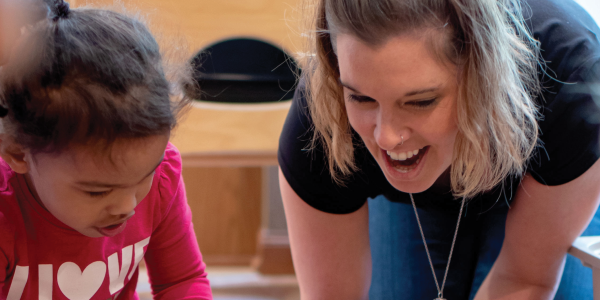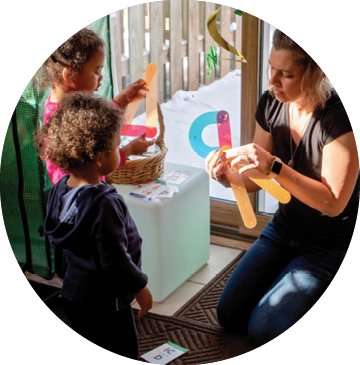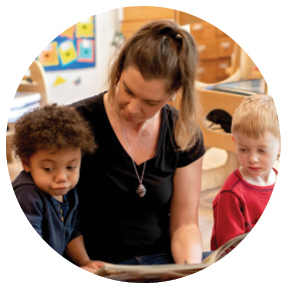Feature Teacher: Janel Moran

You are here
Janel Moran is the director and owner of Honeypie Nature Playschool in McFarland, Wisconsin. She has over 22 years of experience in the early childhood field.
Tell us about yourself!
I began my career in early childhood education during my junior year of high school after taking introductory courses in early childhood education. I found early childhood development and education fascinating and enjoyed working in my practicums so much that I applied for an apprenticeship at a local child care center. That led to me earning an associate degree in early childhood education. In 2009, I opened my family child care program.
I have been married for 19 years and have four children. I enjoy weightlifting, hiking/biking, reading, and spending time outdoors with my family in my free time.
What is something important a child has taught you?
 The outdoors is truly a magical place—in every element of weather and every season! There is always something to explore and learn about in the outdoors, whether it’s a bird chirping, a track left behind, or a puddle from the rain; it is magical in the eyes of a child and a wonder to discover! For example, recently, we were puddle jumping, and the children noticed the ripples our jumps made in the water. Something so small may go unnoticed by an adult in the hustle and bustle of the day, but it can be significant to a young child. They were absolutely fascinated, and their curiosity and interests led me to be fascinated as well. I relaxed, watching the ripples, which reminded me just how nurturing the outdoors can be for children (and adults!).
The outdoors is truly a magical place—in every element of weather and every season! There is always something to explore and learn about in the outdoors, whether it’s a bird chirping, a track left behind, or a puddle from the rain; it is magical in the eyes of a child and a wonder to discover! For example, recently, we were puddle jumping, and the children noticed the ripples our jumps made in the water. Something so small may go unnoticed by an adult in the hustle and bustle of the day, but it can be significant to a young child. They were absolutely fascinated, and their curiosity and interests led me to be fascinated as well. I relaxed, watching the ripples, which reminded me just how nurturing the outdoors can be for children (and adults!).
Over the years, nature has become an integral part of our program because of its impact on the children. I’ve come to enjoy being outdoors on the coldest and windiest of days, though summer is still my favorite.
What strategies would you recommend to build on children’s individual and family strengths, cultural backgrounds, and experiences and to show children and families that you value them?
An environment that offers a welcoming home away from home, with opportunities to connect families with one another and to the program, is very important. I invite families to come into my program at drop-off and pickup times and spend a little time when they are able. This gives them an opportunity to connect with our program and see what we’re learning and doing, and it gives me an opportunity to connect more with them, allowing me to learn more about them, their family, and their culture. I also offer open houses, potlucks, grab-n-go meals, and celebrations for families and children.
Over the last 14 years, the families in my program have grown close to each other as we’ve celebrated life events: welcoming new babies (siblings of children enrolled in my program and my own babies), parents’ engagements and marriages, families moving (including my own family and program’s move five years ago), and achieving accreditation and certification through Nature Explore. We’ve been through it all. It’s what I love about family child care—the families in my program become an extension of my own family.
Describe some ways in which you communicate with families to build and maintain positive and reciprocal relationships.
I believe that a family is a child’s first educator and that a strong relationship between a family and a program is vital in providing a healthy childhood and experience for each child, which is why communication is key. I communicate with families at drop-off and pickup times, and I use a family communication app and social media to share photos, videos, newsletters, and resources with families. I also hold several events throughout the year so our families can connect with our program and one another.
Share a recent situation in which things didn’t go as planned. What happened, and what did you do to make the most of it for you and the children?
The COVID-19 pandemic! While my program remained open, it changed the way our program operated. During shelter-at-home, most of our children continued to attend, while some of the children stayed home. In our sunroom, I set up a space and offered materials our school-aged children needed to do their virtual schooling.
I found that the children staying home missed the children still attending terribly so we offered virtual group times when the children could connect with each other through storytelling, songs, and reading books. Both groups would do simple activities together, such as sharing a favorite book or showing and talking about a favorite toy. Just giving opportunities for the children to talk and engage with each other in a safe way helped foster relationships.
What is your favorite children’s book and why?
Harold and The Purple Crayon, by Crockett Johnson. It was my favorite children’s book as a child and remains my favorite children’s book as an adult. Something as simple as a crayon sparked Harold’s creativity and imagination and opened a world of endless possibilities. His adventures seem so real because of his trusty purple crayon and his strong imagination. My hope is that my children feel like Harold too every time they step foot into my program.
What are you reading now?
Rules of the Red Rubber Ball: Find and Sustain Your Life’s Work, by Kevin Carroll. I just started reading it on a snowy Wisconsin day. I was excited to read it; it had been awaiting me on my desk since the Wisconsin Early Childhood Association Conference. The next book will be The Out-of-Sync Child Has Fun, Revised Edition: Activities for Kids with Sensory Processing Disorder, by Carol Stock Kranowitz. (I am excited to read that book as well!) As a family child care provider and mother of four, having the time to read and enjoy a good “adult” book is rare so I like to stick with shorter books.
How do you take care of yourself?
As a wife, mom of four, and a family child care provider, it’s important to find balance in it all and find balance for myself as an individual! I try to get to the gym a few times a week, where I enjoy listening to my favorite ’80s and ’90s music while lifting weights, riding the stationary bike, and getting a good workout on the rowing machine. It’s important to have the time and space away from the hustle and bustle while caring for my mind, body, and soul.
What is your proudest accomplishment as an educator?
 In 2020, I went back to school (virtually) to obtain my early childhood education administrator’s credential. I was excited about continuing my education as an early childhood educator, but I was also very nervous about how I would balance it with everything else going on in life. It was also an opportunity to show my children that it’s never too late to learn or get a degree, and I graduated on time with the rest of my class with high honors!
In 2020, I went back to school (virtually) to obtain my early childhood education administrator’s credential. I was excited about continuing my education as an early childhood educator, but I was also very nervous about how I would balance it with everything else going on in life. It was also an opportunity to show my children that it’s never too late to learn or get a degree, and I graduated on time with the rest of my class with high honors!
I knew I had to teach when . . .
I first stepped foot in my first practicum setting and felt the joy and wonder of being a child again. I keep my passion and enthusiasm for teaching alive by reflecting on the fact that children will remember the experiences they’ve had in my program 20 years from now—that’s an incredible honor and a powerful motivator to make a positive difference in the life of each and every child who steps through my door.
What is a future professional goal that you have for yourself?
A few years ago, I started presenting workshops about topics such as exploration, learning, and nurturing through nature; effective family engagement; and approaches to sensory learning at local early childhood education conferences. I wanted to share my knowledge and experiences and help support other providers in the field. It was great to hear from attendees about the impact that my workshops made on their programs and to learn about their experiences as well. The networking and relationships made over the years have been wonderful. A future professional goal is to present workshops at other conferences. Being a NAEYC member, I can reach this goal by attending more NAEYC conferences and one day presenting at one.
My teaching style is . . .
play-based, nature-based, and experiential. I believe learning happens everywhere—indoors and out and with all the senses. I also believe in child-led, child-directed learning, and I strive to create an environment and experiences that support the interests and development of each and every child in our program.
I am a NAEYC member because . . .
it has made me a more educated, experienced, well-connected educator and mentor.
How has being part of NAEYC positively impacted your teaching and/or interactions with children?
Being a part of NAEYC has allowed me to continue my learning and education in early childhood education, from reading publications such as Teaching Young Children, NAEYC books, and other content to expanding my knowledge and networking by attending NAEYC conferences. The education and experiences provided by NAEYC have helped me to implement effective practices in my program and learn from other educators. From creating a beautiful outdoor environment to introducing the children to ramps and pathways and early math learning, NAEYC has made numerous positive impacts on my teaching and interactions with the children in my program.
The theme for the issue focuses on leading and managing an early learning program. How does this connect to what you do in your work with young children?
Operating my program as the owner and provider for the last 14 years has taught me that organization, open communication, and family partnerships are key! There is a lot to juggle as a business owner. I also found completing an administrative credential in early childhood education helpful as a business owner. I gained many valuable skills through completing my administrator’s credential, including an increased understanding of standard operating procedures in early childhood education settings; financial management and planning; how to better predict supply and demand; approaches to marketing, funding, and collaboration with community organizations and agencies; advocacy and working for public policy changes; and how to create a business plan for my program’s expansion.
Photos courtesy of Amy Zimmerman.
Copyright © 2023 by the National Association for the Education of Young Children. See permissions and reprints online at NAEYC.org/resources/permissions.